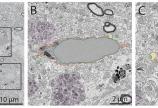Dark matters
- Jessica Skelton

A UVic team is shedding light on why some brain cells go to the dark side and damage the brain—and how we can prevent it.
Marie-Ève Tremblay, an associate professor with the Division of Medical Sciences at UVic, admits she felt stressed out during her early career. On top of working as a postdoctoral fellow, she was pregnant with her first child and spending her free time learning how to eat properly.
Instead of struggling, Tremblay found inspiration in her situation. “It was so challenging that I started thinking about how environmental challenges like psychological stress and diet might affect microglia,” she says, referencing the brain’s resident immune cells and the focus of her lab’s research.
Fast forward nearly a decade, and Tremblay, who is a Tier 2 Canada Research Chair in Neurobiology of Aging and Cognition, and her team are now pretty certain that these stressors can turn microglia to the dark side—figuratively and literally.
Microglia normally patrol the brain, gobbling up waste and unnecessary connections between neurons. When a person endures different kinds of stress, however, the brain becomes populated with dark microglia—shadowy versions of the immune cells that are prone to destroying valuable parts of the brain.
Tremblay’s research and collaborations have shown that dark microglia can increase ten-fold in models of schizophrenia, chronic stress, depression and neurodegenerative diseases, such as Alzheimer’s and other forms of dementia, as well as during aging. When these cells prune away too many of the wrong synapses, they can cause some of the learning, memory and other cognitive deficits we see in those conditions. Similarly, poor maternal diet can cause dark microglia to destroy neurological connections important for memory development in early post-natal offspring. Tremblay suspects this rogue pruning behaviour could also be directed toward the brain’s vasculature system, contributing to changes associated with neurodevelopmental, neuropsychiatric and neurodegenerative diseases. It’s possible dark microglia could even cause leaks in the blood-brain barrier, letting in all kinds of threats.
“Dark microglia have a tight association with disease, and both the environmental challenges and the diseases themselves are associated with high numbers of dark microglia,” she says. “The cells are common to all of these diseases, suggesting they could serve as one mechanism for various associated conditions.”
Fortunately, research in the Tremblay lab has found evidence that lifestyle changes could eliminate and prevent dark microglia, and may repair the damage already done. The team is currently investigating the use of ketogenic diet, and their research will also soon include stress-relieving activities such as exercise and socializing.
“I really think it’s possible to change brain health with simple things,” says Tremblay, though she adds her research will also lead to more targeted pharmaceutical treatments to supplement those lifestyle changes if needed.
The key to gaining this control will be in understanding where dark microglia come from and how they function. Her lab’s research suggests that dark microglia are simply normal microglia in a stressed, malfunctioning state. If that’s the case, then therapies could potentially revert the stressed immune cells back to normal, Tremblay says. For example, her lab’s research suggests dark microglia are more reliant on sugar while their healthy counterparts can use ketone bodies. If a patient switches to a keto or low-carb diet—one of the potential therapies—then only the healthy cells would be fed. “If dark microglia are not provided with their source of energy, maybe they would just revert to normal microglia—if they were a state, that is,” she explains.
Another theory is that dark microglia are unique cells that can’t be normalized, and there is evidence they may even be senescent (resistant to cell death). In this case, therapies would need to eliminate the cells. (For example, there are already medications to remove senescent cells.)
“I think in the lab, everyone is convinced that healthy microglia hold the key to overall brain health,” Tremblay says. “If we understand how to keep them healthy and how to control dark microglia, we will have beneficial outcomes.”
No matter if dark microglia are normalized or eradicated, Tremblay says it’s important the therapies don’t harm healthy immune cells or prevent them from doing their normal functions. If they do, there will be other issues with learning and memory, and the lack of immune cells could lead to infection and other damages.
And so the research continues for Tremblay and her students, as do the stressful sources of inspiration. The Tremblay lab is currently researching the effects of viral infection such as COVID-19, lack of sleep and neurodegenerative diseases associated with aging, as well as potential therapies such as cannabinoids and exposure to nature.
“I think our research is really based on our life experience and, for me, it’s really important that trainees find something they’re really passionate about,” she says.
Risk factors
Environmental challenges and lifestyle risk factors known to cause dark microglia include:
- Western diet
- Viral infection
- Maternal immune responses caused by stress, illness, etc.
- Aging (i.e., the long-term effect of stressors on microglia as we age)
The Tremblay lab is also currently or planning to investigate the effects of these stressors:
- Smoking
- Lack of exercise
- Poor water quality
- Pollution
- Cannabis and alcohol use
- Sleep disturbances
Therapies
The following lifestyle factors are currently under investigation to see if they could help prevent, eliminate and repair damage caused by dark microglia:
- Low-carb diets
- CBD (Cannabidiol)
- Meditation
- Plasmalogens
On the bright side?
It’s also possible that dark microglia aren’t all bad. Preliminary results of a new study in the Tremblay lab suggest dark microglia are abundant and active during early post-natal development, pruning away unnecessary connections between neurons much like normal microglia. Similarly, dark microglia seem to appear in young and adolescent brains during times of additional development. She suspects this activity is normal as it doesn’t result in any pathology, and the cells seem to disappear when they’re no longer needed.
“Maybe they are beneficial initially, but we’re not sure about it,” she says. “We want to understand them during normal development, and then we can see what’s different in terms of function between this normal development and all these contexts of environmental challenge and pathology where they become highly abundant.”
Whether dark microglia are initially beneficial or not, Tremblay says it would be good to gain control over these cells. That way we could stop any pathological remodeling before it causes too much harm and potentially trigger the pruning behaviour when it’s beneficial—such as during development and when neurons become too active during times of stress.
Photos


